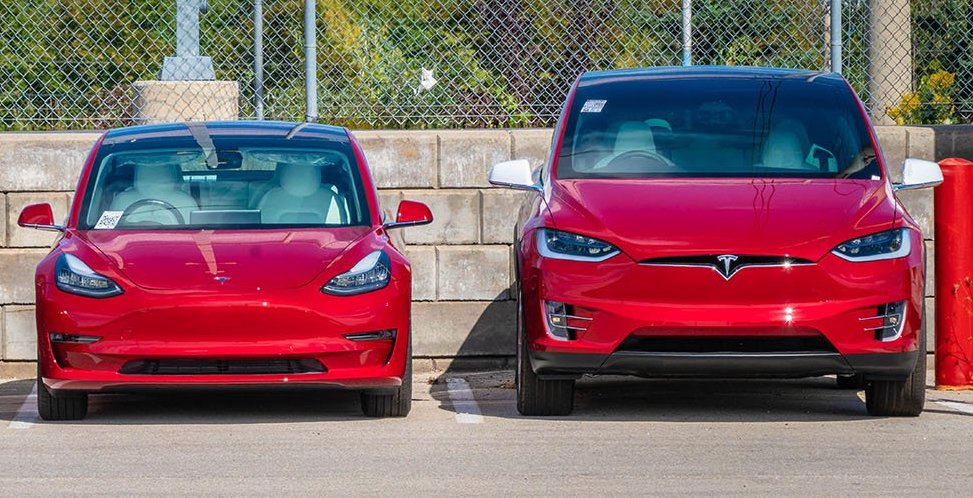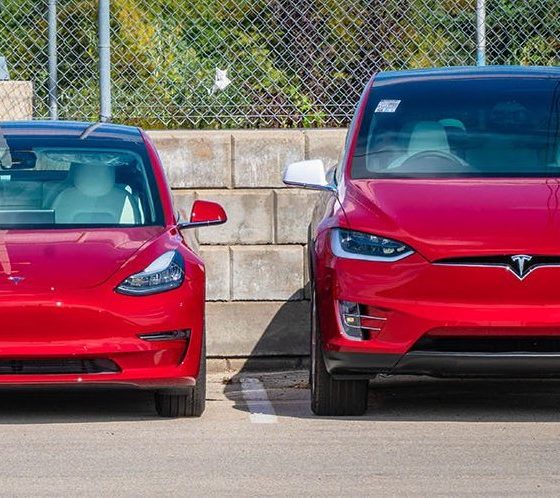The Kelley Blue Book (KBB) 2019 Best Resale Value Award Winners are in, and Tesla’s Model 3 has landed at the top of the electric vehicle category with a projected 69.3% resale value after 36 months and 48.7% after 60 months. Its SUV brethren, the Model X, achieved a worthy status of its own, placing 2nd in the same category at 56.7% (36 months) and 34.3% (60 months). While Tesla’s fleet of vehicles are high-value luxury cars, their ability to retain a large portion of their original selling price as used cars is yet another data point driving their desired position in the consumer market.
The recognition given by the long-trusted consumer automotive resource in its announcement of the award spoke highly of the vehicle’s appeal to buyers, something which played a role in its valuation: “The Tesla Model 3 has a cultural magic and desirability about it that made people willing to wait months and even years to own one. People don’t like Tesla Model 3s — they crave them,” noted KBB in a tweet. This sentiment from KBB as a 92-year veteran in car assessments, of course, adds yet another confirmation of something many Tesla owners and reservation holders already assumed to be true.
The @Tesla #Model3 has a cultural magic and desirability about it that made people willing to wait months and even years to own one — that's how you hold on to your resale value over time. #KBBBestResaleValue
— Kelley Blue Book (@KelleyBlueBook) January 24, 2019
Thanks to Tesla’s customer-driven design and development process, features such as class-leading range, a vast Supercharging network, over-the-air software updates, great-looking design, and overall technology serving convenient, practical, and entertainment purposes, the company’s two newest vehicles are handily standing out against competitors. In KBB’s overview page detailing the Model 3’s category win, more praise along these lines was offered: “For those who can afford it, the smallest Tesla offers usability, joyful road manners, and an intriguing glimpse of a gasoline-free future.” The vehicle’s 5-star safety rating from the National Highway Traffic and Safety Administration (NHTSA) in every category was also noted as a driving price point in a general overview page about the Model 3.

The annual KBB Best Resale Value Awards compares a variety of vehicle resale metrics over 36 and 60 month time frames and then sorts them into three categories: Best Brand/Luxury Brand (evaluating makers’ overall portfolio), Overall Top Ten Winners (best resale values in all categories), and Category Winners (24 categories covering every class, shape, and price). According to the KBB website detailing the award, the values are calculated based on several factors including vehicle specification and trim levels, sales data, market data, and segment competition, among others. While the general system is meant to provide a fair comparison, certain numbers are worth considering more broadly for a fuller picture of Tesla’s Model 3 and Model X in the market.
Given the chance to compete in categories that would fit outside of an electric vehicle-only comparison, the Model 3 would beat every other sedan by a large margin at the 36-month mark. The Best Mid-Size Car, Subaru Legacy, was given a 51.8% resale value at 36 months and 38.4% at 60 months. As Best Luxury Car, the Audi A7 came in at 47.3% and 32.3%, respectively. Compared to the gasoline-powered winner, Chevy Tahoe, in the Best Full-Size SUV category at 55% and 43%, the Model X would have prevailed at 56.7% and 34.3%.
Perhaps as more legacy auto manufacturers come over to the all-electric side, the categories will become more agnostic about vehicle power sources for awards.

News
Tesla FSD fleet is nearing 7 billion total miles, including 2.5 billion city miles
As can be seen on Tesla’s official FSD webpage, vehicles equipped with the system have now navigated over 6.99 billion miles.

Tesla’s Full Self-Driving (Supervised) fleet is closing in on almost 7 billion total miles driven, as per data posted by the company on its official FSD webpage.
These figures hint at the massive scale of data fueling Tesla’s rapid FSD improvements, which have been quite notable as of late.
FSD mileage milestones
As can be seen on Tesla’s official FSD webpage, vehicles equipped with the system have now navigated over 6.99 billion miles. Tesla owner and avid FSD tester Whole Mars Catalog also shared a screenshot indicating that from the nearly 7 billion miles traveled by the FSD fleet, more than 2.5 billion miles were driven inside cities.
City miles are particularly valuable for complex urban scenarios like unprotected turns, pedestrian interactions, and traffic lights. This is also the difference-maker for FSD, as only complex solutions, such as Waymo’s self-driving taxis, operate similarly on inner-city streets. And even then, incidents such as the San Francisco blackouts have proven challenging for sensor-rich vehicles like Waymos.
Tesla’s data edge
Tesla has a number of advantages in the autonomous vehicle sector, one of which is the size of its fleet and the number of vehicles training FSD on real-world roads. Tesla’s nearly 7 billion FSD miles then allow the company to roll out updates that make its vehicles behave like they are being driven by experienced drivers, even if they are operating on their own.
So notable are Tesla’s improvements to FSD that NVIDIA Director of Robotics Jim Fan, after experiencing FSD v14, noted that the system is the first AI that passes what he described as a “Physical Turing Test.”
“Despite knowing exactly how robot learning works, I still find it magical watching the steering wheel turn by itself. First it feels surreal, next it becomes routine. Then, like the smartphone, taking it away actively hurts. This is how humanity gets rewired and glued to god-like technologies,” Fan wrote in a post on X.
News
Tesla starts showing how FSD will change lives in Europe
Local officials tested the system on narrow country roads and were impressed by FSD’s smooth, human-like driving, with some calling the service a game-changer for everyday life in areas that are far from urban centers.

Tesla has launched Europe’s first public shuttle service using Full Self-Driving (Supervised) in the rural Eifelkreis Bitburg-Prüm region of Germany, demonstrating how the technology can restore independence and mobility for people who struggle with limited transport options.
Local officials tested the system on narrow country roads and were impressed by FSD’s smooth, human-like driving, with some calling the service a game-changer for everyday life in areas that are far from urban centers.
Officials see real impact on rural residents
Arzfeld Mayor Johannes Kuhl and District Administrator Andreas Kruppert personally tested the Tesla shuttle service. This allowed them to see just how well FSD navigated winding lanes and rural roads confidently. Kruppert said, “Autonomous driving sounds like science fiction to many, but we simply see here that it works totally well in rural regions too.” Kuhl, for his part, also noted that FSD “feels like a very experienced driver.”
The pilot complements the area’s “Citizen Bus” program, which provides on-demand rides for elderly residents who can no longer drive themselves. Tesla Europe shared a video of a demonstration of the service, highlighting how FSD gives people their freedom back, even in places where public transport is not as prevalent.
What the Ministry for Economic Affairs and Transport says
Rhineland-Palatinate’s Minister Daniela Schmitt supported the project, praising the collaboration that made this “first of its kind in Europe” possible. As per the ministry, the rural rollout for the service shows FSD’s potential beyond major cities, and it delivers tangible benefits like grocery runs, doctor visits, and social connections for isolated residents.
“Reliable and flexible mobility is especially vital in rural areas. With the launch of a shuttle service using self-driving vehicles (FSD supervised) by Tesla in the Eifelkreis Bitburg-Prüm, an innovative pilot project is now getting underway that complements local community bus services. It is the first project of its kind in Europe.
“The result is a real gain for rural mobility: greater accessibility, more flexibility and tangible benefits for everyday life. A strong signal for innovation, cooperation and future-oriented mobility beyond urban centers,” the ministry wrote in a LinkedIn post.
News
Tesla China quietly posts Robotaxi-related job listing
Tesla China is currently seeking a Low Voltage Electrical Engineer to work on circuit board design for the company’s autonomous vehicles.

Tesla has posted a new job listing in Shanghai explicitly tied to its Robotaxi program, fueling speculation that the company is preparing to launch its dedicated autonomous ride-hailing service in China.
As noted in the listing, Tesla China is currently seeking a Low Voltage Electrical Engineer to work on circuit board design for the company’s autonomous vehicles.
Robotaxi-specific role
The listing, which was shared on social media platform X by industry watcher @tslaming, suggested that Tesla China is looking to fill the role urgently. The job listing itself specifically mentions that the person hired for the role will be working on the Low Voltage Hardware team, which would design the circuit boards that would serve as the nervous system of the Robotaxi.
Key tasks for the role, as indicated in the job listing, include collaboration with PCB layout, firmware, mechanical, program management, and validation teams, among other responsibilities. The role is based in Shanghai.
China Robotaxi launch
China represents a massive potential market for robotaxis, with its dense urban centers and supportive policies in select cities. Tesla has limited permission to roll out FSD in the country, though despite this, its vehicles have been hailed as among the best in the market when it comes to autonomous features. So far, at least, it appears that China supports Tesla’s FSD and Robotaxi rollout.
This was hinted at in November, when Tesla brought the Cybercab to the 8th China International Import Expo (CIIE) in Shanghai, marking the first time that the autonomous two-seater was brought to the Asia-Pacific region. The vehicle, despite not having a release date in China, received a significant amount of interest among the event’s attendees.










